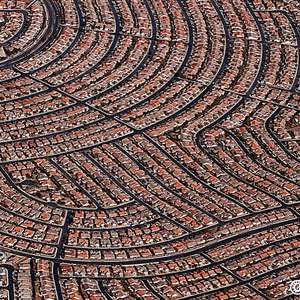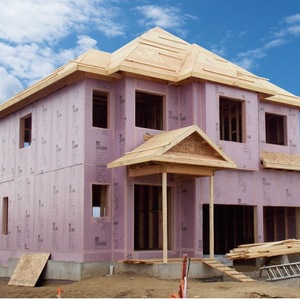
The National Association of Home Builders (NAHB) is not prone to mincing words. In a recent statement issued by the lobbying group, the NAHB and its current chairman, Carl Harris, decried the fact that two federal agencies, the Department of Housing and Urban Development (HUD) and the Department of Agriculture (USDA), are now required—effective May 28 of this year—to build new housing stock to the latest model energy codes. “This senseless nationwide codes mandate will significantly raise housing costs,” Harris says.
For single-family homes and multifamily low-rise buildings (up to three stories), the 2021 International Energy Conservation Code (IECC) will apply, while multifamily buildings with four or more stories will be built to the ASHRAE 90.1-2019 standard. Such compliance paths are in keeping with the Energy Independence and Security Act (EISA) of 2007, which establishes procedures for HUD and USDA to “adopt periodic revisions” to the IECC and ASHRAE 90.1, provided those agencies can establish said revisions “will not negatively affect the affordability and availability of housing covered by EISA.” This final determination from the Federal Register has confirmed just that.
Narrative with choice numbers
The NAHB has adopted the opposite tack. According to its statement, this policy will “exacerbate the housing affordability crisis,” “do little to curb overall energy use,” and be “a deterrent to new construction at a time when the nation desperately needs to boost its housing supply to lower shelter inflation costs.” The organization attempts to back up these claims by citing two in-house studies.
The first is a consumer impact brief created by the NAHB-affiliated Home Builders Association of Greater Kansas City, which indicates “that building to the 2021 IECC can add up to $31,000 to the price of a new home.” The second is a cost analysis study created by Home Innovation Research Labs, an independent subsidiary of NAHB, which claims that it can “take up to 90 years for a home buyer to realize a payback on the added cost” of a new home.
Weekly Newsletter
Get building science and energy efficiency advice, plus special offers, in your inbox.
In each case, a standard reference house with approximately 2500 square feet of conditioned living area is used to calculate these figures. However, the NAHB is clearly cherry-picking numbers to promote a narrative that, while not entirely false in certain contexts, is far from universal.
Missing pieces
The NAHB is in the business of getting homes built, a laudable mandate if ever there was one. But with this statement, the group ignores any associated emissions reductions that come with adoption of these codes, which can be substantial when scaled up at a municipal or statewide scale. (The words ‘emissions,’ ‘carbon dioxide,’ and ‘greenhouse gas’ are all noticeably absent from NAHB’s statement.) Rather, they concede in passing that “targeting new home construction is the wrong approach to reduce energy consumption” because, alas, existing homes “built to modern energy codes are already energy efficient.”
The first point is debatable. The second point is true in some but not all instances. And each point is wholly irrelevant to the other. This is a smokescreen.
Further, the NAHB is evidently concerned about upfront costs to builders and first-time home buyers (yes, greater efficiency does add costs; HUD estimates more than $7000 on average per single-family home), but conveniently glosses over the fact that the topic at hand is federally funded housing, not private development.
Other shortcomings
Their statement ignores the existence of many funding mechanisms, both public and private, that enable communities to build low-impact, high-performance dwellings that are also affordable, or allow homeowners to get IRA-funded rebates and tax credits for making efficiency upgrades.
Their statement fails to acknowledge the long-term costs, both hard and soft, of allowing retrograde building energy codes to persist in the name of building more on the cheap. (Prior to this revision, HUD and USDA were operating on the 2009 IECC and ASHRAE 90.1-2007, which on average are far less efficient that their 2021 and 2019 counterparts, respectively.)
Their statement disregards the fact that low-income households spend on average 8% of their income on energy consumption versus the national average of 3%, which of course is an issue that better insulation, better windows, and better HVAC systems, per stricter energy codes, can help solve.
Their statement doesn’t account for the social costs of emitting more carbon.
In other words, the statement willfully omits context.
Industry leaders respond
In a recent Instagram post from Croft, a Maine-based company specializing in carbon-capture, pre-fab buildings, they provide an amusing yet poignant response to NAHB’s statement, titled “Croft’s ten point plan to make a damn difference.” Their points range from the modestly improbable (“End fossil fuel subsidies so that foam is immediately unaffordable”) to the very achievable (“Design simply and with local materials so laypeople can bodily participate in changing their built environments for the better”).
However aspirational Croft’s list may be—I don’t see us abandoning sprawl and attempting E.O. Wilson’s “Half Earth” vision any time this millennium, or next—they touch on some crucial points that Carl Harris and his organization have not taken into account. And many of those points are largely backed up, with added nuance, by several industry leaders in the green building arena.
Brett Little, education manager with GreenHome Institute, takes issue with Harris’s lamenting that “implementation challenges” will lead to third parties needing “to manage the compliance process.” Little, speaking on his own behalf, frames the issue a bit differently. By allowing third-party green building certification programs (e.g., LEED, Enterprise Green, and others) to enter the fray, this should be of keen interest to home builders, he says, because “these programs offer choice and flexibility in meeting these standards by focusing on different aspects of the five pillars of residential green building: Energy, Health, Materials, Water, and Place.”
Residential designer and Pretty Good House co-author Michael Maines notes how “any attempt at regulations that affect the cost of the house are things [the NAHB] will oppose. I wish they cared about construction quality, indoor air quality, safety, or environmental impact, but they clearly don’t.”
Maines further observes that the NAHB is “including a 20% contractor markup, which is larger than typical here. Assuming they aren’t exaggerating their cost estimates, the upgrades would add 7.8% to the cost of a basic, poorly performing home.” New homes should of course meet “basic requirements for health, safety, and operating costs,” he says, but then pivots to emphasize the fact that multi-family buildings, which represent the fastest growing housing sector in the U.S., are generally the “much more affordable and responsible” path.
Amanda Pederson, an associate with Minneapolis design firm DJR Architecture, which has partnered extensively with the city’s public housing authority (MPHA), highlights how that agency prioritizes applications that “are at least 15% better than code, which is above and beyond what HUD and USDA [will be using].” That increase represents a significant “shift in the design of mechanical systems in multifamily projects, to a higher efficiency than most developers may be accustomed to. That said, if affordable housing developments aren’t on the forefront of adopting enhanced sustainability features, who will be?”
Steve Pohlman, CEO of GAPScore, a survey and analysis tool for homeowners to implement “green upgrades,” acknowledges that this is “a loaded topic,” while in the same breath offering a sobering take: “Affordable housing could use the upgrades. Affordable housing inspections don’t include energy efficiency or green features that can potentially make the property more efficient. It’s also a matter of climate and social justice. Saying we can’t do it because of cost is not an option.”
Complex solutions for complex problems
Regardless on one’s professional position or political leanings, there is consensus among those in the know that the issue of reconciling the need for designing better performing homes, the need for more affordable housing stock, and absorbing the added upfront costs of doing both is not an easy riddle to solve. This makes the NAHB’s statement that much harder to digest, because amidst all their misdirection and citing of seemingly complex statistics, the organization is attempting to frame this as an all-or-nothing issue. More stringent energy codes = higher building costs = less incentive for builders to build, and the aspiring homeowner is the one who bears the brunt of this “ill-conceived policy.”
This simplistic equation doesn’t come close to addressing the myriad obstacles that presently stand in the way of developing high- and medium-density affordable housing, designed for efficiency and occupant wellbeing.
Yes, to Croft’s point, the persistence of fossil fuel subsidies is definitely one culprit, as are outmoded zoning laws; a lack of transparency in building material supply chains; and a national shortage of home builders, construction workers, and other skilled trades. (The latter is something the NAHB acknowledges has impacted housing availability and affordability.)
Housing attainability is a crisis just about everywhere you look, in both boom and stagnant markets, and there is no easy fix. Having a federally mandated standard code in place would help, but the feasibility of that ranks right up there with “Use the overwhelming wealth of the world’s nations to build housing instead of fighting with each other” (#2 on Croft’s list).
So, that leaves us with this question for the NAHB: What makes you think that continually building to the lowest common denominator will actually help solve this crisis? Please feel free to answer in the comments below, preferably with a ten-point plan, but any format will do.
_______________________________________________________________________
Justin R. Wolf is a Maine-based writer who covers green building trends and energy policy. His first book, “Healing Ground, Living Values: Stanley Center for Peace and Security”, was just published by Ecotone.
















2 Comments
I don't typically find myself on the same side of an issue as the NAHB but in this case I do, for this reason.
Look at the draft 2024 IRC. It's reverting insulation requirements back to the 2018 level. I'm not privy to the code committees' internal discussions. But I gather from this that there is an acknowledgement that the 2021 insulation increases probably went beyond the minimum, or even recommended values and into the high-performance range, possibly to a point beyond that of diminishing returns.
Example: Look at wall insulation requirements for zones 4 and 5. It could very well be that the 2021 mandate, effectively forcing people to do exterior insulation, adds considerably more cost than just the insulation itself. In particular it complicates the handling of door and window openings considerably. This means higher skill levels (higher labor cost), more risk of poorly installed doors and windows (more future repair cost), and overall more labor. I haven't enumerated all the associated costs, just those that come immediately to mind.
These kinds of costs, and more, need to be acknowledged.
For product manufacturers, designers, and builders, to change their work to the 2021 requirements, only to find, 3 years from now, that the requirement has been dropped back to the 2018 level, is very disruptive and definitely impacts the cost of doing business.
The resources consumed by all this would be much better focused on programs to improve the performance of the existing housing stock. This is a vastly larger contributor to the environmental impact than new housing.
I believe this is why New York is supposedly skipping the 2021 IRC, and will be implementing 2024 next.
Log in or create an account to post a comment.
Sign up Log in